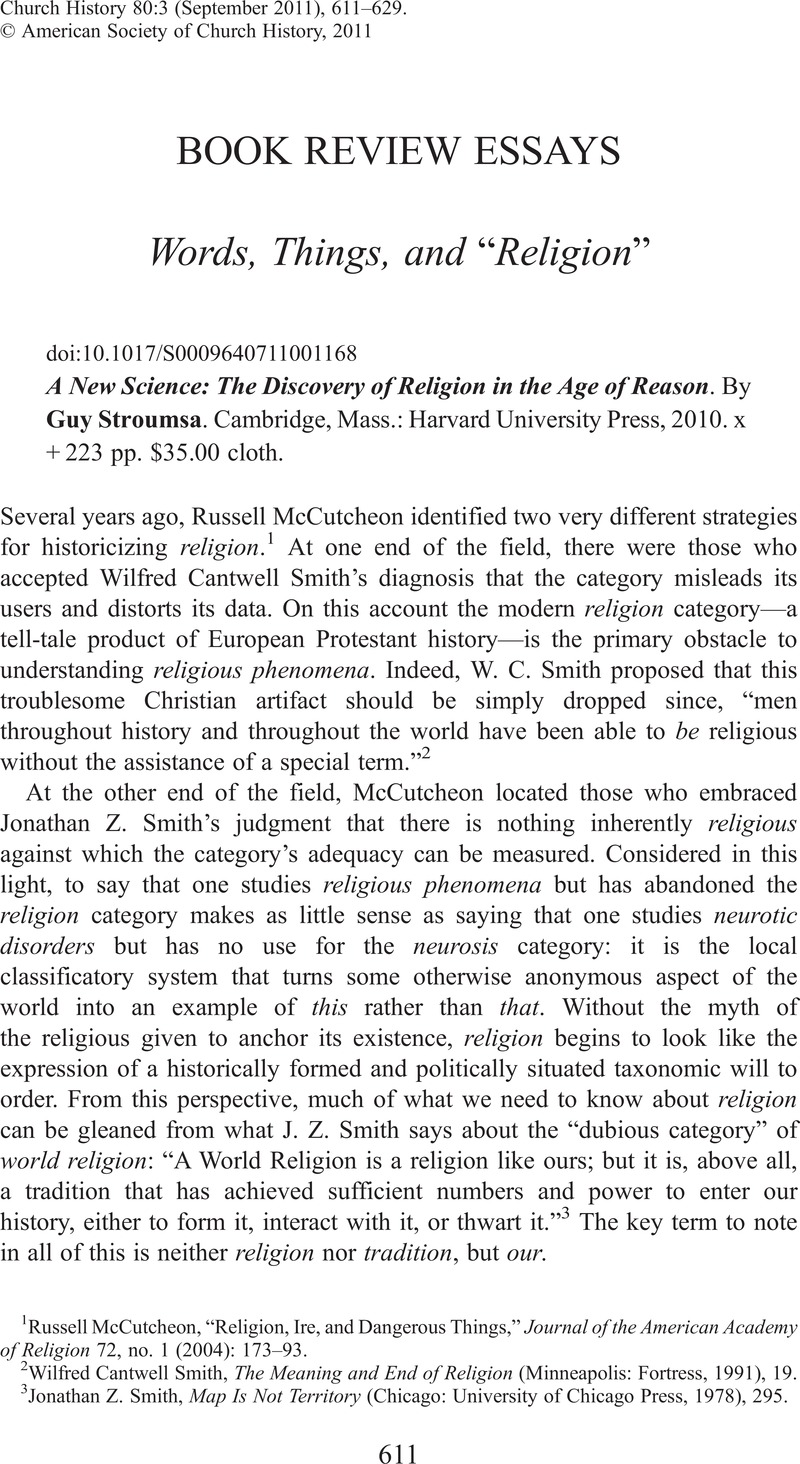Published online by Cambridge University Press: 29 September 2011

1 McCutcheon, Russell, “Religion, Ire, and Dangerous Things,” Journal of the American Academy of Religion 72, no. 1 (2004): 173–93CrossRefGoogle Scholar.
2 Smith, Wilfred Cantwell, The Meaning and End of Religion (Minneapolis: Fortress, 1991), 19Google Scholar.
3 Smith, Jonathan Z., Map Is Not Territory (Chicago: University of Chicago Press, 1978), 295Google ScholarPubMed.
4 Stroumsa, Guy, A New Science: The Discovery of Religion in the Age of Reason (Cambridge, Mass.: Harvard University Press, 2010)Google Scholar. All further references to this text will be made parenthetically in the body of the essay.
5 Strenski, Ivan, “Diagnosing Religion,” in What Is Religion? Origins, Definitions, Explanations, ed. Idinopulos, Thomas A. and Wilson, Brian C. (Leiden: Brill, 1998), 118Google Scholar.
6 King, Richard, Orientalism and Religion (London: Routledge, 1999), 40Google Scholar.
7 See, for example, Bono, James, Language of God, Language of Man (Madison: University of Wisconsin Press, 1995)Google Scholar; Ashworth, William, “Emblematic Natural History and the Renaissance,” in Cultures of Natural History, ed. Jardine, N., Secord, J. A., and Spary, E. C. (Cambridge: Cambridge University Press, 1996), 17–37Google Scholar; Harrison, Peter, Protestantism: The Bible and the Rise of Science (Cambridge: Cambridge University Press, 1999)Google Scholar.
8 Ashworth, William, “Natural History and the Emblematic World View,” in Reappraisals of the Scientific Revolution, ed. Lindberg, David and Westman, Robert (Cambridge: Cambridge University Press, 1990), 318Google Scholar.
9 Harrison, Peter, “Religion” and the Religions in the English Enlightenment (Cambridge: Cambridge University Press, 1990)CrossRefGoogle Scholar.
10 Foucault, Michel, The Order of Things: An Archaeology of the Human Sciences (New York: Vintage, 1970), 41Google Scholar. All further references to this text will be made parenthetically in the body of the essay.
11 See, for example, Prado, C. G., “Foucault, Davidson and Interpretation,” in Foucault and Philosophy, ed. O'Leary, Timothy and Falzon, Christopher (Malden, Mass.: Wiley-Blackwell, 2010), 99–117CrossRefGoogle Scholar.
12 See, for example, Chidester, David, Savage Systems (Charlottesville: University of Virginia Press, 1996)Google Scholar; Day, Matthew, “Godless Savages and Superstitious Dogs,” Journal of the History of Ideas 69, no. 1 (2008): 49–70Google Scholar.
13 See, for example, Buell, Denise Kimber, Why This New Race? (New York: Columbia University Press, 2005)Google Scholar; King, Karen, What Is Gnosticism? (Cambridge, Mass.: Harvard University Press, 2005)Google Scholar.
14 See, for example, Haidu, Peter, The Subject Medieval/Modern: Text and Governance in the Middle Ages (Stanford, Calif.: Stanford University Press, 2004)Google Scholar; Rice, Charles, The Emergence of the Interior: Architecture, Modernity, Domesticity (London: Routledge, 2007)Google Scholar.
15 Foucault, Michel, The Archaeology of Knowledge (New York: Pantheon, 1972), 47–48Google Scholar.
16 Holdrege, Barbara, “What Comes After the Post?” in In Comparison a Magic Still Dwells, ed. Patton, Kimberley and Ray, Benjamin (Berkeley: University of California Press, 2000), 85Google Scholar.
17 Cohen, Richard S., “Why Study Indian Buddhism?” in The Invention of Religion, ed. Peterson, Derek R. and Walhof, Darren R. (Camden, N.J.: Rutgers University Press, 2002), 34Google Scholar.